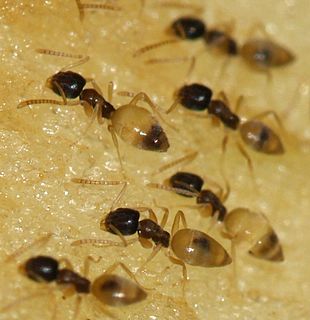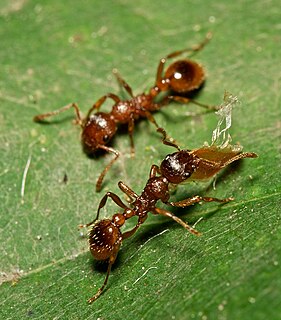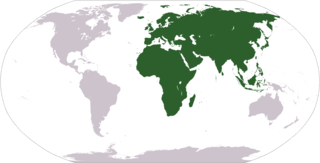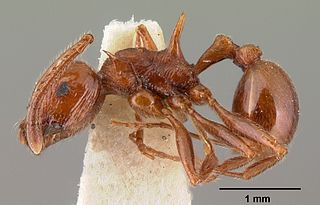
Ponerinae is a subfamily of ants in the Poneromorph subfamilies group, with about 1,600 species in 47 extant genera, including Dinoponera gigantea - one of the world's largest species of ant. Mated workers have replaced the queen as the functional egg-layers in several species of ponerine ants. In such queenless species, the reproductive status of workers can only be determined through ovarian dissections.

Myrmicinae is a subfamily of ants, with about 140 extant genera; their distribution is cosmopolitan. The pupae lack cocoons. Some species retain a functional sting. The petioles of Myrmicinae consist of two nodes. The nests are permanent and in soil, rotting wood, under stones, or in trees.

Dolichoderinae is a subfamily of ants, which includes species such as the Argentine ant, the erratic ant, the odorous house ant, and the cone ant. The subfamily presents a great diversity of species throughout the world, distributed in different biogeographic regions, from the Palearctic, Nearctic, Afrotropical region and Malaysia, to the Middle East, Australian, and Neotropical regions.

Tapinoma is a genus of ants that belongs to the subfamily Dolichoderinae. The genus currently comprises 74 described species distributed worldwide in tropical and temperate regions. Members of are generalized foragers, nesting in a wide variety of habitats, ranging from grasslands, open fields, woodlands, to inside buildings. The majority of species nest in the ground under objects such as stones or tree logs, other species build nests under bark of logs and stumps, in plant cavities, insect galls or refuse piles.

Myrmica is a genus of ants within the subfamily Myrmicinae. It is widespread throughout the temperate regions of the Holarctic and high mountains in Southeast Asia.

Aphaenogaster is a genus of myrmicine ants. About 200 species have been described, including 18 fossil species. They occur worldwide except in South America south of Colombia, Sub-Saharan Africa, and Antarctica.

Plagiolepis is an ant genus of the formic acid-producing subfamily Formicinae. The genus is found in tropical and temperate regions of the Old World.

Pachycondyla is a ponerine genus of ants found in the Neotropics.

Crematogastrini is a tribe of myrmicine ants with 64 genera and 8 fossil genera.

Anochetus is a genus of carnivorous ants found in the tropics and subtropics throughout the world.

Myrmecina is a genus of ants in the subfamily Myrmicinae. It contains 51 species distributed in North America, Europe, northern Africa, India east, Korea, Japan and Australia.

Dolichoderus is a genus of ants found worldwide.

Technomyrmex is a genus of ants in the subfamily Dolichoderinae. With 98 species, it is one of the largest and most diverse ant genera in the Dolichoderinae. The genus distributed throughout the tropical and subtropical zones with most species occurring in the Oriental-Malesian and Afrotropical regions. One species, Technomyrmex albipes is a tramp ant now widespread throughout the tropics due to human activities.

Cerapachys is a genus of ants in the subfamily Dorylinae. Species are mainly myrmecophagous ants which raid the nests of other ants for prey. The genus is distributed widely throughout the tropical and subtropical regions of the world, with the majority of species known from the Indo-Australian region.

Lordomyrma is a genus of ants in the subfamily Myrmicinae.

Carebara is a genus of ants in the subfamily Myrmicinae. It is one of the largest myrmicine genera with more than 174 species distributed worldwide in the tropics and the Afrotropical region. Many of them are very tiny cryptic soil and leaf litter inhabitants. They nest in rotten wood to which the bark is still adherent in the Afrotropical region, or may be lestobiotic nesting near other ant species. Some species are known to exist parasitically within termite nests. Little is known about the biology of the species. However, they are notable for the vast difference in size between queens and workers.





















